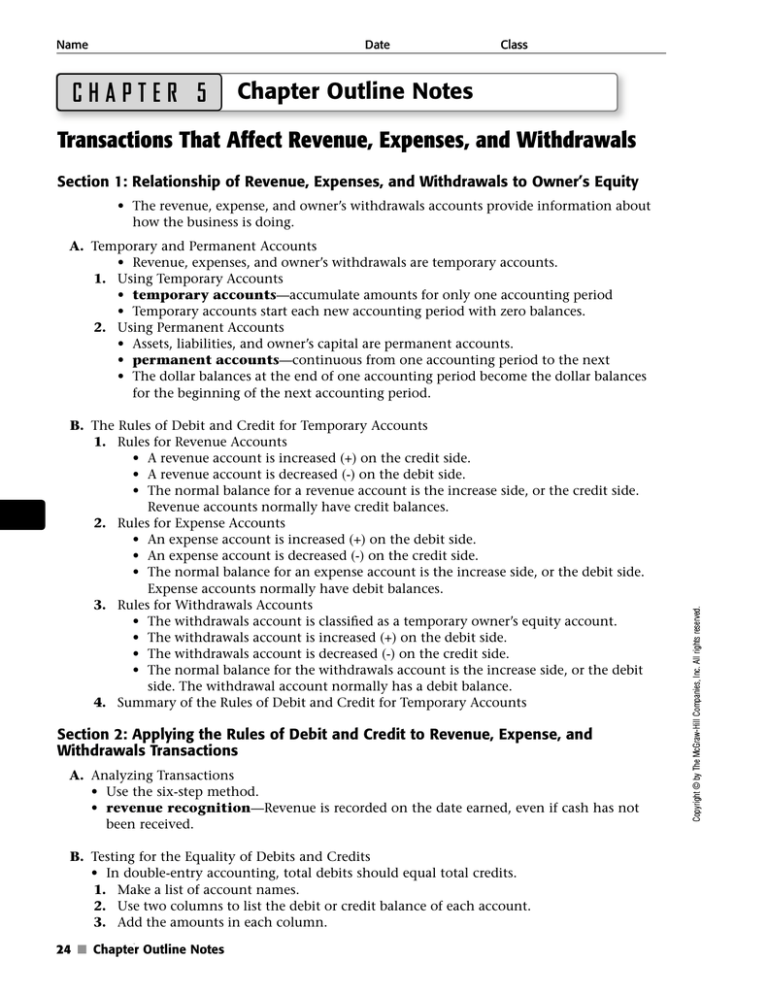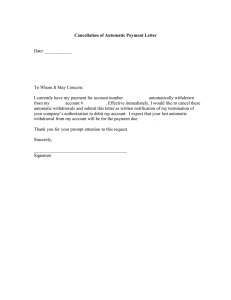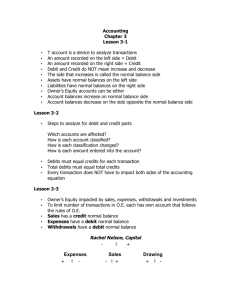
Name
Date
CHAPTER 5
Class
Chapter Outline Notes
Transactions That Affect Revenue, Expenses, and Withdrawals
Section 1: Relationship of Revenue, Expenses, and Withdrawals to Owner’s Equity
• The revenue, expense, and owner’s withdrawals accounts provide information about
how the business is doing.
B. The Rules of Debit and Credit for Temporary Accounts
1. Rules for Revenue Accounts
• A revenue account is increased (+) on the credit side.
• A revenue account is decreased (-) on the debit side.
• The normal balance for a revenue account is the increase side, or the credit side.
Revenue accounts normally have credit balances.
2. Rules for Expense Accounts
• An expense account is increased (+) on the debit side.
• An expense account is decreased (-) on the credit side.
• The normal balance for an expense account is the increase side, or the debit side.
Expense accounts normally have debit balances.
3. Rules for Withdrawals Accounts
• The withdrawals account is classified as a temporary owner’s equity account.
• The withdrawals account is increased (+) on the debit side.
• The withdrawals account is decreased (-) on the credit side.
• The normal balance for the withdrawals account is the increase side, or the debit
side. The withdrawal account normally has a debit balance.
4. Summary of the Rules of Debit and Credit for Temporary Accounts
Section 2: Applying the Rules of Debit and Credit to Revenue, Expense, and
Withdrawals Transactions
A. Analyzing Transactions
• Use the six-step method.
• revenue recognition—Revenue is recorded on the date earned, even if cash has not
been received.
B. Testing for the Equality of Debits and Credits
• In double-entry accounting, total debits should equal total credits.
1. Make a list of account names.
2. Use two columns to list the debit or credit balance of each account.
3. Add the amounts in each column.
24 ■ Chapter
Spanish Outline
Language
Notes
Resources
Copyright © by The McGraw-Hill Companies, Inc. All rights reserved.
A. Temporary and Permanent Accounts
• Revenue, expenses, and owner’s withdrawals are temporary accounts.
1. Using Temporary Accounts
• temporary accounts—accumulate amounts for only one accounting period
• Temporary accounts start each new accounting period with zero balances.
2. Using Permanent Accounts
• Assets, liabilities, and owner’s capital are permanent accounts.
• permanent accounts—continuous from one accounting period to the next
• The dollar balances at the end of one accounting period become the dollar balances
for the beginning of the next accounting period.
Name
Date
CHAPTER 5
Class
Concept Assessment
Transactions That Affect Revenue,
Expenses, and Withdrawals
PART A
Accounting Vocabulary
Total
Points
Student’s
Score
62
(6 points)
Directions: Using terms from the following list, complete the sentences below. Write the letter of the
term you have chosen in the space provided.
A. capital
B. expense accounts
C. permanent accounts
G
D. revenue accounts
E. revenue recognition
F. temporary accounts
G. withdrawal
0. An amount of money taken out of the business by the owner is a
.
1.
record business income only.
2.
are used to record information for only one accounting period.
3. The
account shows the amount of the owner’s investment, or equity, in
a business.
4. Accounts that are used to record information continuously from one accounting
period to the next are called
.
5.
are used to record the costs and services used by a business.
6. Recognizing and recording revenue on the date it is earned even if cash has not
been received on that date is known as
.
Part B Effects of a Transaction on an Account
(24 points)
Copyright © by The McGraw-Hill Companies, Inc. All rights reserved.
Directions: For each of the business transactions below, indicate whether the left or right side of the
account is affected and whether the account balance is increased or decreased.
Left
0. A credit of $850 to Accounts Payable
Right
Increase
✓
✓
Decrease
1. A debit of $400 to B. Barns, Withdrawals
2. A debit of $200 to Advertising Expense
3. A credit of $300 to Cash in Bank
4. A credit of $450 to Fees
5. A debit of $650 to Rent Expense
6. A credit to B. Barns, Capital of $1,500
7. A credit to Accounts Receivable of $925
8. A debit to Office Supplies of $40
9. A debit of $3,000 to B. Barns, Capital
10. A debit of $150 to Accounts Payable
11. A debit to Accounts Receivable of $2,000
12. A debit to Cash in Bank of $750
Concept Assessment ■ 1
Name
Date
Class
Concept Assessment cont.
PART C Analyzing Transactions Using T Accounts
(20 points)
Directions: Use T accounts to analyze each of the transactions below. Use the following
account names.
Cash in Bank
Accounts Receivable
Martha Russo, Withdrawals
Service Fees
0. Provided typing services and
billed Tim Ochi $400 for the
work.
Advertising Expense
Telephone Expense
Accounts Receivable—Tim Ochi
400
Service Fees
400
1. Paid $45 cash for an advertisement in the newspaper.
2. Martha Russo withdrew $250
cash for personal use.
3. Provided word processing
services for $975 cash.
4. Paid the telephone bill with
a check for $90.
5. Received $400 on account from
Tim Ochi.
PART D Testing for the Equality of Debits and Credits
(12 points)
Account
Balance
Debits
Credits
Cash in Bank
$3,725
$3,725
$
Accounts Receivable
800
Office Supplies
200
Office Equipment
8,500
Accounts Payable
3,000
G. Steiner, Capital
5,905
G. Steiner, Withdrawals
Fees
625
6,550
Advertising Expense
650
Rent Expense
725
Utilities Expense
230
Totals
2 ■ Concept
Quick Quiz
Assessment
Copyright © by The McGraw-Hill Companies, Inc. All rights reserved.
Directions: The balance of each account is indicated directly after the account name. Indicate the
normal balance side of each account by placing the dollar amount in the appropriate debit or credit
column. Add each column. The total debit balance should equal the total credit balance.
Name
Date
CHAPTER 5
Class
Quick Quiz
Transactions Transactions That Affect Revenue,
Expenses, and Withdrawals
PART A
True or False
Directions: Read each of the following statements to determine whether the statement is true or false.
Copyright © by The McGraw-Hill Companies, Inc. All rights reserved.
Answer
T
F
1. The normal balance side for a revenue account is the debit
side.
T
F
2. “Credit” means the increase side of an account.
T
F
3. A credit to an expense account decreases the account
balance.
T
F
4. Withdrawals are increased on the debit side.
T
F
5. Revenue is increased on the credit side.
T
F
6. Expenses are decreased on the credit side.
T
F
7. The basic accounting equation may be expressed as
A L OE.
T
F
8. The left side of a T account is always the debit side.
T
F
9. You may have two debits and one credit as long as the
amounts are equal.
T
F
10. A debit to an expense account and a credit to a capital
account will result in the basic accounting equation being
out of balance.
T
F
11. Capital is always increased by credits.
T
F
12. Debits decrease the withdrawals account.
Quick Quiz ■ 3
Name
Date
Class
Quick Quiz cont.
PART B
Identify the Normal Balance
Directions: For each T account below, indicate with an (N) the normal balance side. The first
account has been completed as an example.
Cash in Bank
Debit
(N)
Credit
Rent Expense
Debit
Credit
Accounts Payable
Debit
Credit
Fees Revenue
Debit
Credit
Jones, Capital
Debit
Credit
Jones, Withdrawals
Debit
Credit
PART C Complete the T Account
Directions: Analyze the transactions below and enter them in the T accounts provided.
1. Ms. Adams invested $12,000 cash in the business.
2. Bought office equipment for cash, $1,000.
3. Bought a computer on account, $3,000.
Office Equipment
Accounts Payable
J. Adams, Capital
4 ■ Quick
Chapter
Quiz
Quiz
Computer Equipment
Copyright © by The McGraw-Hill Companies, Inc. All rights reserved.
Cash in Bank
Name
Date
CHAPTER 5
Class
Chapter Quiz
Transactions That Affect Revenue, Expenses, and Withdrawals
True or False
Directions: Read each of the following statements to determine whether each statement is true or false.
Answer
T
F
1. The owner’s capital account is increased by debits.
T
F
2. Revenue represents the debit side of the owner’s capital
account.
T
F
3. Expenses decrease the balance in the capital account.
T
F
4. The rules of debit and credit for expenses are the same as
those for withdrawals.
T
F
5. Temporary capital accounts are used by a business only
once.
T
F
6. A withdrawal increases the assets of the business.
T
F
7. Revenue accounts have a normal credit balance.
T
F
8. The owner’s capital account has a normal debit balance.
T
F
9. Expenses and withdrawals both have normal debit balances.
T
F
Copyright © by The McGraw-Hill Companies, Inc. All rights reserved.
10. The owner’s equity in the business is increased by revenue
and decreased by expenses and withdrawals.
Chapter Quiz ■ 5
Name
Date
CHAPTER 5
Class
Demonstration Problems
Transactions That Affect Revenue, Expenses and Withdrawals
PROBLEM 5–1 Analyzing Permanent and Temporary Capital Accounts
The large T account below represents the capital account for Maxine Andrews. The smaller
T accounts are for the temporary accounts. Place the following account names on the
appropriate T account.
Maxine Andrews, Capital
Maxine Andrews, Withdrawals
Ticket Sales
Travel Expense
For each T account:
(1) Indicate the increase () and decrease () sides.
Copyright © by The McGraw-Hill Companies, Inc. All rights reserved.
(2) Indicate the normal balance side.
Demonstration
Chapter Outline
Problems
Notes ■ 25
Name
Date
Class
Demonstration Problems cont.
PROBLEM 5–2 Analyzing a Revenue Transaction
On July 25, Andrews Promoters received $4,500 in revenue from cash ticket sales.
1. Which accounts are affected?
2. What is the classification of each account?
is a(n)
account.
is a(n)
account.
3. Is each account increased or decreased?
is
.
is
.
4. Which account is debited, and for what amount?
is debited for $
.
5. Which account is credited, and for what amount?
is credited for $
.
Copyright © by The McGraw-Hill Companies, Inc. All rights reserved.
6. What is the complete entry in T-account form?
26 ■ Demonstration
Math Review forProblems
Accounting
Name
Date
Class
Demonstration Problems cont.
PROBLEM 5–3 Analyzing an Expense Transaction
On July 30, Andrews Promoters issued a check for $300 to Ace Airways for travel expenses.
1. Which accounts are affected?
2. What is the classification of each account?
is a(n)
account.
is a(n)
account.
3. Is each account increased or decreased?
is
.
is
.
4. Which account is debited, and for what amount?
is debited for $
.
5. Which account is credited, and for what amount?
is credited for $
.
Copyright © by The McGraw-Hill Companies, Inc. All rights reserved.
6. What is the complete entry in T-account form?
Math
Demonstration
Review for
Lesson
Accounting
Problems
Footer
Plans ■ 27




